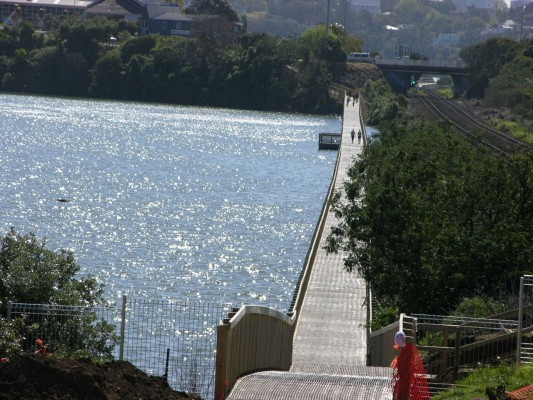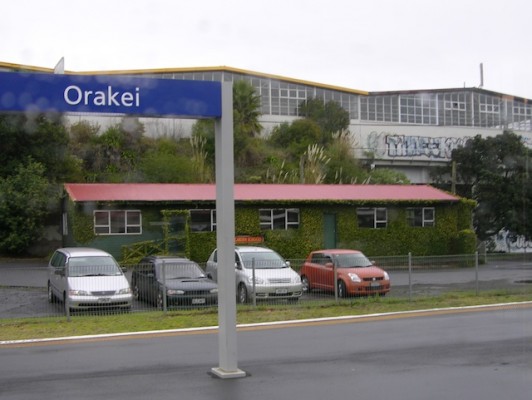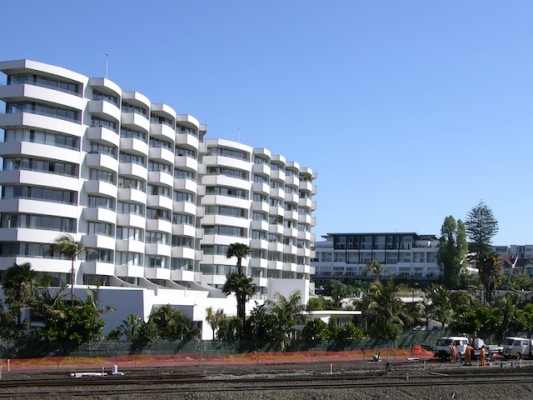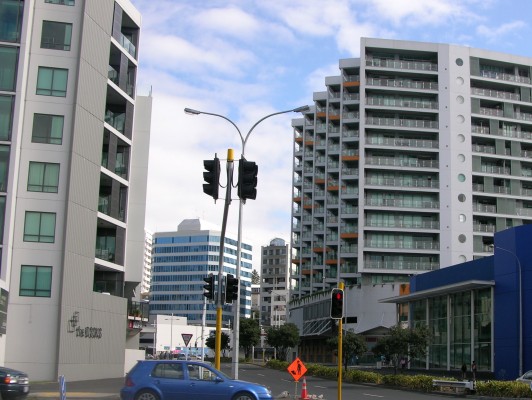Orakei Plan Change Goes Ahead
So after what feels like many years, the controversial Orakei Point plan change got the tick from a majority (14-6) of the new Auckland Councillors this afternoon.
This means a rezoning of the peninsula to a mixture of site-specific mixed use and open space to allow for high-density development.
What is planned by Redwood Group and the Equinox Group is an 84,000 square metre development involving 700 apartments, retail and office space around the present Kings Barn area.
An independent panel of commissioners this week had recommended it go ahead.
And of special interest to rail observers fans was any impact on the neighbouring railway line, around the Orakei station area and the fact that the developer has to gain control over KiwiRail’s land and air space above the railway line within the plan change area.
The Orakei Point master plan makes provision for an enclosed tunnel over the rail line and corridor through Orakei Point, with the tunnel located under a development podium.
The building of a podium over the existing railway line, and this land and airspace is an integral part of the plan change proposal and was also critically necessary for the plan change to be implemented.
KiwiRail presented evidence and submissions at this hearing in relation to the effects of the proposal on the operation of the rail line and one KiwiRail official said in an email:
“I can confirm that subject to being able to agree to satisfactory commercial terms, in the sole opinion of KiwiRail, that we are prepared to sell you corridor land and air rights at Orakei Station of course always subject to Ministers consent. I can also confirm that we have instructed a valuer”.
 The panel had heard Kiwi Rail, Ports of Auckland Ltd and the former ARTA raise “significant concerns about the lack of ‘recognition’ to the existing and future use of the North Island Main Truck rail line that runs through the site.”
The panel had heard Kiwi Rail, Ports of Auckland Ltd and the former ARTA raise “significant concerns about the lack of ‘recognition’ to the existing and future use of the North Island Main Truck rail line that runs through the site.”
Kiwi Rail, while supportive of the change in principle, requested that it provide for the railway and rail operations, a nationally and regionally strategic asset, to continue to operate efficiently and effectively now and into the future.
The change as originally drafted did not provide for this. Ports had had similar concerns, saying that freight (mainly in containers) was ‘shipped’ to and from the port on the main trunk rail line, and with the ‘inland’ port at Wiri and the projected increase of freight being moved by train, this route was critical to the ongoing efficient operation of the port – and the social, cultural and economic well being generated by the port.
The report continues:
“We heard in evidence from Kiwi Rail, POAL and ARTA about the likely increase in rail operations. Ms Butler, Senior Resource Management Act Advisor for Kiwi Rail advised that currently a total of 549 trains go via the Orakei Station over a seven day week (or 78 trains on average per day). While this total is mostly passenger services it also includes freight.
Ms Butler also advised, and this was confirmed in ARTA’s evidence (Mr Waddell), that Kiwi Rail in conjunction with ARTA is currently in the implementation phase of increasing the number of commuter passenger services across the region including services at Orakei Station. She also advised that freight volumes would most likely increase between the Port and the Wiri Inland Port. POAL (Mr Gill – Business Development and Strategy Manager) confirmed that POAL would be transporting more freight by rail, including between the Waterfront Port (the Port) and the Wiri Inland Port.
He advised that currently there were on average 29 return freight train movements to and from the Port, and this did not include any trains on Sunday. The witness further advised that most of these movements occurred between 9 am and 11 pm, with approximately 15% occurring outside of this time. Usually there are no freight movements by rail between 6am and 9pm and 3pm to 6pm as at these times the rail line is used exclusively for passenger trains. Mr Gill predicted that over time trains will increase in length and there will be a much greater number of freight trains on the line.
He considered that there would be up to 95 trains per week by 2014/15 and 168 per week by 2019/20, and at full capacity movements could be 240 per week. This would also mean that trains would be moving freight on Sundays.
A further and relevant point that Mr Gill made was that post electrification of the Auckland rail networks (where passenger trains will be quiet and there will be less noise and vibration than currently experienced from diesel trains), freight trains will likely to continue to arrive into and leave from the Port hauled by diesel locomotives. This is because the equipment used at the rail grid to load and unload containers onto the trains would conflict with the overhead catenary system used to power electric trains.
The main concerns raised by these submitters were that:
- the Plan Change did not ‘carry over’ the Special Purpose 3 Zone over the rail corridor designation. This zoning specifically provided for the rail operation over the rail corridor designation (including across the land included in Plan Change 260) and in particular that no noise controls were specified in Plan Change 260
- that the noise controls and other planning provisions specified in the Plan Change, designed to protect the amenity of those living on the site, as well as those working and recreating there, could not be met by trains, and would not protect residential amenity
- the reverse sensitivity effects from train noise and vibration, especially given the likely increase in both freight and passenger trains, would be a significant adverse effect on POAL and Kiwi Rail.
Planners for the Ports expressed concern that while the proposed Orakei Point Mixed Use Zone provides for rail activity as a permitted activity, rail activities will need to comply with the noise and vibration controls of the zone in order to achieve the permitted status.
The planners recommended a Special Purpose 3 zone (SP3 zone) which is the protection of the Isthmus’ significant transport corridors for continued use as transport modes and for alternative use as a conveyor of utility services. This would be within the rail designation corridor, and the SP3 zone only applies to a height of 7 metres once the rail podium has been constructed over the rail designation corridor.
It also recommended, in reference to noise, that no residential accommodation shall be located closer than 80m to any exposed rail track unless a report from a suitably qualified acoustic consultant demonstrated that the external criterion of 60 dB can be achieved.
An increase in traffic around was a major concern among those submitting but the panel said it do not agree with the submissions that sought the plan change be declined on the basis of traffic effects. “We believe that those effects can be appropriately addressed.”
On carparking, it noted the council wanted to encourage use of transport other than cars so recommended that a parking threshold of 75% of the maximum parking requirements be required.
A number of submitters expressed concern at the loss of the park and ride facility. The plan change provides for a park and ride for up to 200 spaces (the current number) as a permitted activity.
This has been a controversial development. It will be interesting to see the reaction from those who support and oppose it, whether KiwiRail comes through with the podium and how our waterfront takes shape now.














15 Comments
This could be the first (or second if we count Sylvia Park) opportunity to build a new community area centred around PT…IF there are binding responsibilities on the developer that are strictly enforced so that the result is a good quality building that also enhances the attractiveness of catching the train from Orakei and the surrounding area and protects the rail corridor for future development.
I am cautiously optimistic but the conditions relating to the rail corridor in particular in any agreement with the devloper must be clearly laid out and enforced. I do not want to see an agreement reached and then see a devloper be able to try and back out of . The message should be “We`re open-minded about this plan but if you want to build, you do it on our terms and we`ll make sure you`re held to them”.
This will be good if done well. It’s great as it’s above a rail line and a new all weather station will be included. (I hope a focus is put on a bus interchange) Also I hope it includes berthing for small boats and with a focus on the water around it. Another great idea would be to have a cycle tunnel go next to the rails tracks and open up a cycle route from Panmure (or further out) to the CBD along side the current tracks. I do think that the Scene apartments in the CBD was a big mistake and everyone knows that. Going forward the new council is different and won’t let that happen again.
I think that this is positive and will likely be very popular providing it is done right as it will be only a quick journey straight into town.
Is this the final nail in the coffin of any future eastern motorway plans? I certainly hope so!
I hope they are reserving space for extra tracks? Also these residents had better not turn out like those around Eden Park, who move next to an amenity then complain about it- including it’s likely increase in business….. Otherwise, fantastic!
That`s my chief concern that Patrick..that the corridor will still be able to be developed - particulalrly extra line(s) put in so that more freight can be railed from/to the port while also increasing passenger services.
The plans show space for three tracks, but really they should be allowing for four. My main concern though, is what happens to all the park and ride spaces there presently? Will all those users be required to drive into the CBD instead?
@Kettlewatch It was a joke, awindup. It didn’t take long to work!
I wonder if these kind of consent continue to be passed that there will be more support for electrification of all rail services on Auckland Suburban Railway Lines and extension of eletric wires to Hamilton?
The rezoning proposal isn’t so much of an issue. the real issue comes when we get detailed designs, and I hope the urban design panel goes over it with a fined tooth comb.
We can’t muck this one up, a high quality development is necessary otherwise proposals for medium density all over the city will be hurt.
I must add Redwood dont have the best history, they built the Ob-Scene complex. They seem notorious for having sketches look far, far nicer than whats built.
See here for their past projects -
http://www.redwoodgroup.co.nz/index.cfm?action=residential&page=archive
Yip Luke - Let Redwood know very clearly what`s expected and that the council will be going over the plans with a fine tooth coomb and will come down on Redwood with a tonne of bricks if they don`t do what they promise.
At last a prod in the right direction for KiwiRail and POAL to do something about the excessive noise, pollution and vibration they generate. Their submissions show outdated arrogance. Freight trains are welcome but it’s time to meet 21st Century challenges. 60 decibels withing 80 metres of houses or better and acceptance of World Health Organisation guidelines would be a great start. As for claiming you won’t be able to run electric freight trains. Hogwash surely? Seems to work overseas. Be proactive and you’ll get along with your neighbours. You both have environmental policies, make incremental improvements instead of waiting for legislation to force dramatic and expensive change.
Mostly the issue has been with lazy/poor quality developers that haven’t included proper sound proofing in their properties.
Granted part of the issue is accoustic insulation and the Council’s District Plan should address that too, but outside areas and public spaces also need levels of protection from escessive noise. The line from the Port to Wiri is very different from some shunting yard at Westfield in terms of impact on residents.